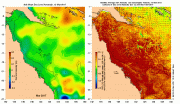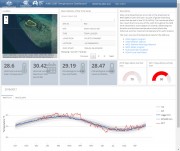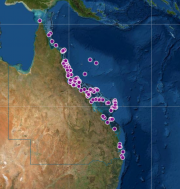NESP TWQ Round 4 - Project 4.2 - Oceanographic drivers of bleaching in the GBR: from observations to prediction
This project produced a summary of the major publicly available temperature observations from physical oceanographic data collected on the Great Barrier Reef during the recent 2016 and 2017 mass coral bleaching events. The article 'Drivers of Bleaching on the Great Barrier Reef - Compilation of temperature data from 2015, 2016 and 2017' presents a compilation and analysis, summary plots of the data that can be interrogated and daily climatologies, as well as links to source data from multiple observing platforms.
This project aimed to understand how local, regional and global oceanographic and meteorological processes influence the severity and spatial variability of thermally driven coral bleaching for the Great Barrier Reef (GBR) and Torres Strait.
All available relevant environmental observations of the recent bleaching events were gathered to be more easily discoverable to researchers and managers via the compilation article (see link above).
The data assessed how well the eReefs models are modelling the recent warming during bleaching events and analysed the reasons behind the variations of bleaching response. 3D versions of remotely sensed bleaching products by NOAA and BoM were produced and a seasonal prediction capability for marine heatwaves was developed.
This project developed near realtime 3D Degree Heating Weeks data products that were integrated into the CSIRO eReefs model runs.
A workshop at the ACRS 2019 conference was run on accessing oceanic data for coral reef research. The manuals used in the workshop are now available.
All the reports, fact sheets and journal articles developed by this project are available from the Project 4.2 NESP Tropical webpage.
Images
Datasets

The analysis of existing bleaching observations and data resulted in three key outcomes: identification of key bleaching patterns, analysis of contributing factors, and recommendations for future monitoring and mitigation strategies.
This desktop analysis of existing bleaching observations and data delivered three key outcomes:

This project seeks to understand how local, regional and global oceanographic and meteorological processes influence the severity and spatial variability of thermally driven coral bleaching for the Great Barrier Reef (GBR) and Torres Strait. All available relevant environmental observations of the recent bleaching events will be gathered to be more easily discoverable to researchers and managers via a gateway/summary webpage.

This dataset is a compilation of available ocean temperature data, aerial and in-water bleaching observations during the 2016 and 2017 bleaching events on the Great Barrier Reef in order to estimate the total reef area impacted by coral bleaching and thermal heat stress. A total of 982 reefs (56.8% reef area of the GBR) were surveyed in 2016 and 781 reefs (50.9% reef area of the GBR) surveyed in 2017.

The dashboard set comprises individual web pages for each sensor/location. Each dashboard includes a map showing the location of the station, basic statistics and time series plots. If enough data is available (more than 10 years), a climatology of the temperature record is calculated. The SSTAARS climatology is also plotted along the sensor data. Hourly time series plots are also available at each instrument’s depth.
See "Interactive map of this dataset" resource link below for a navigation map to the dashboard web pages.

This collection of temperature logger data has been produced to cover the most recent back to back bleaching events in the Great Barrier Reef to be used as a reference data set for coral bleaching studies. The data comes from over 90 permanent temperature logger locations within the reef from the AIMS temperature logger program, 12 AIMS automatic weather stations, 6 AIMS-IMOS mooring sites and 15 Queensland Environment wave-buoys temperature loggers. The data were restricted from late 2015 to mid-2017.






